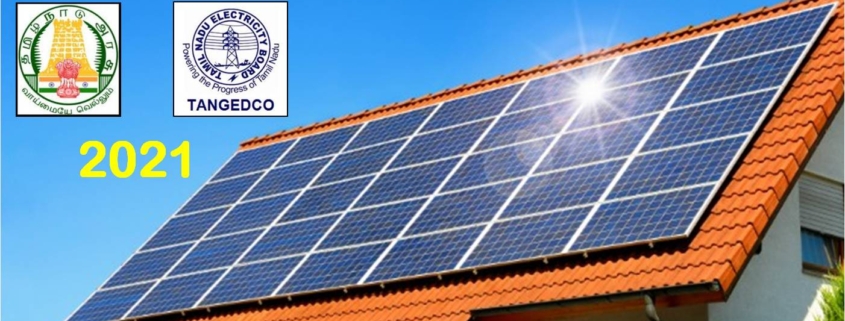Net metering – New TN policy
Tamil Nadu government has announced new solar policy for different sectors in Oct 2021. There is huge benefit for the residential sector in this policy. This policy allows net metering for residents who install solar (upto 10KW) and export surplus electricity to the grid. As we know, Ongrid systems can be installed on residences and (through a net meter) they can export the surplus electricity/energy to the grid. These exported units are deducted from the imported units which are consumed from the grid (for example in night).
Note that this is very beneficial compared to previous policy (from Mar 2019) where about Rs. 2 (residential) is paid for each exported unit to grid. All these are explained in details in this article/blog below. While, export can be done from hybrid systems also, ongrid system is used in the descriptions here for simplicity. Also, Goverment-of-India has announced increased Solar Subsidy from 2024.
For More Videos visit our YouTube Channel
Solar Ongrid system and its operation
In Ongrid solar PV systems, solar energy produced by the solar panels is converted to AC (alternating current) by a solar ongrid inverter. The output of the solar ongrid inverter is connected to the distribution board of the residence. The solar energy flows to the loads of the house (lights, fans and other appliances). If the solar energy produced is more than what the building loads consume, the surplus energy will automatically be exported to the TANGEDCO distribution network (the grid). If there is less solar energy produced than what the loads of the building require, the shortfall will be drawn from the grid (energy import). Many houses are drastically reducing their TNEB bills with the help of Ongrid systems.
Net Meter working principle
A convention meter at homes measures only one way flow of energy i.e. energy from the grid. Solar net-meter can measure both energy import (from the grid to the consumer) and energy export (from the consumer to the grid). These meters are known as bidirectional energy meters or import-export energy meters. They can track both export and import separately. After installation of solar ongrid system, the existing service meter at the residence needs to be replaced with the net-meter provided by the TANGEDCO.
Electricity bill with solar net-metering
With solar net-metering the consumer pays for the difference between import and export energy (the net-metered energy). Example: if a consumer imports 1000 kWh (units) during a billing cycle (2-Month) and exports 800 kWh. The electricity bill for this cycle will be calculated for 200 kWh (1000-800). If the exported energy exceeds the imported energy, the net exported kWh will be carried over to the next billing cycle as credit.
During a 12 months period (the settlement period) the maximum energy exported that will be credited by TANGEDCO is 90% of the energy import. Example: During the settlement period, if there is a total import of 5,000 kWh and a total export of 6,000 kWh. Of the 6,000 kWh exported 4,500 kWh is eligible for adjustment with the import kWh (90% of 5,000 kWh).
Billing options under new policy for GISS (Grid Interactive PV Solar Energy Generating System)
The TNERC (Tamil Nadu Electricity Regulatory Commission) had issued the tariff order on rooftop solar generation. The Commission introduced the various energy billing methodologies and accounting processes for different consumers (Domestic, Commercial and Industrial) in Order No.8 of 2021 dated 22-10-2021.
- Net Metering
- Net Billing or Net feed-in
- Gross Metering
The above 3 are detailed below followed by the summary table.
Net metering:
- As per New Net- metering Policy, all domestic consumers (Upto 10KW) are eligible for net metering mechanism up to the level of sanctioned load/ contracted demand.
- Domestic consumers have an additional option of choosing the net-feed mechanism.
- Domestic consumers who have been provided with the solar net-feed-in facility as per TNERC Order No.3 of 2019 shall have option to migrate to the solar energy net metering mechanism as provided for in this order to avoid discrimination within the same category of consumers.
- Billing Methodology: Energy exported is deducted from energy imported in units to arrive at the net imported or exported energy. The net imported or exported energy is billed or credited or carried over on the basis of retail tariff.
Net billing or Net Feed-in:
- In net billing or net feed-in process, the solar energy net billing or net feed-in mechanism will be available to all electricity consumer categories (except hut and agriculture) irrespective of tariff and voltage levels up to the level of sanctioned load/contracted demand up to a maximum capacity of 999 kW.
- Net billing Feed-in-Tariff: The monetary value of the imported energy is debited at retail tariff; the monetary value of exported energy is credited at feed-in tariff. The monetary value of the exported energy is deducted from the monetary value of imported energy to arrive at the net amount to be billed.
Gross Metering:
- In Gross Metering Process, the existing and new consumers of all categories except domestic category and also the generators are eligible for gross metering mechanism irrespective of tariff. The minimum size of the Solar System that can be set up under Gross Metering mechanism shall be 151 kWp up to a maximum capacity of 999 kW.
- Gross Metering Billing: Gross metering involves selling entire solar energy generated to licensee. The exported solar energy is credited at the feed in tariff.

Wishing all residential consumers,
Happy green years ahead!









Leave a Reply
Want to join the discussion?Feel free to contribute!